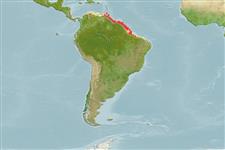Common names from other countries
Environment: milieu / climate zone / depth range / distribution range
Ecologie
marien; brak water demersaal; diepte 10 - ? m (Ref. 5217). Tropical; 13°N - 9°S
Western Atlantic: West Indies and the Atlantic coasts of Central and South America to southeastern Brazil.
Lengte bij maturiteit / Grootte / Gewicht / Leeftijd
Maturity: Lm ?, range 24 - ? cm
Max length : 40.0 cm TL mannelijk / geslacht onbekend; (Ref. 3791); 35.0 cm TL (female); common length : 25.0 cm TL mannelijk / geslacht onbekend; (Ref. 5217)
Mainly found in brackish estuaries but also in marine and hyper-saline waters (Ref. 5217). During reproduction, they gather in small groups at the mouth of coastal rivers and creeks. Reproduction occurs in the early part of the year. Oviparous, eggs are pelagic and non-adhesive (Ref. 205). Eggs which are rich in yolk are spawned by the millions. Upon hatching, juveniles move up to the swamps and coastal rivers over long distances, to seek for food and to protect themselves against predators (Ref. 35237). Marketed fresh or salted (Ref. 5217). The roe is marketed salt-pickled and dried and considered a delicacy (Ref. 5217).
Levenscyclus en paargedrag
Maturities | Voortplanting | Spawnings | Egg(s) | Fecundities | Larven
Spawning seems to take place in small groups in river mouths. Females lay millions of relatively large eggs rich in yolk.
Thomson, J.M., 1978. Mugilidae. In W. Fischer (ed.) FAO species identification sheets for fishery purposes. Western Central Atlantic (Fishing Area 31). Vol. 3. [pag. var.]. FAO, Rome. (Ref. 3791)
Status op de Rode Lijst van het IUCN (Ref. 130435)
CITES (Ref. 128078)
Not Evaluated
Gevaar voor de mens
Harmless
Gebruik door de mens
Visserij: van minder commercieel belang
Tools
Speciale rapporten
Download XML
Internetbronnen
Estimates based on models
Preferred temperature (Ref.
115969): 26.7 - 28.1, mean 27.4 (based on 46 cells).
Fylogenetische diversiteitsindex (Ref.
82804): PD
50 = 0.5000 [Uniqueness, from 0.5 = low to 2.0 = high].
Bayesian length-weight: a=0.00977 (0.00595 - 0.01605), b=2.91 (2.78 - 3.04), in cm Total Length, based on LWR estimates for this species & Genus-body shape (Ref.
93245).
Trofisch niveau (Ref.
69278): 2.0 ±0.1 se; based on diet studies.
Weerstandsvermogen (Ref.
120179): Hoog, minimale populatieverdubbelingstijd minder dan 15 maanden (Preliminary K or Fecundity.).
Fishing Vulnerability (Ref.
59153): Low vulnerability (24 of 100).
